Last week, I mentioned several utilities that are helpful but time constraints caused links to the various websites to be omitted. the links are now present. You'll find last week's program here.
This week's podcast was recorded and edited on a notebook computer but the final production took place on the primary desktop system. An update to the video drivers on the desktop computer rendered the system unbootable and time constraints meant that I had to proceed with the recording process while running a system restore on the desktop. Sometimes one gets too far out on the bleeding edge of technology. But that's what backup is for!
Finding the Right File Sharing Program
Windows 8 includes 7GB of free storage on Microsoft's SkyDrive platform but you don't need to install Windows 8 to use SkyDrive. It works just fine on Windows 7 once you've installed a small SkyDrive application. You don't even have to use a Windows computer. SkyDrive works on Macs, too. In fact, it's easy to access your files on SkyDrive even if you don't have a computer. Even a phone with a Web browser will do. Against that backdrop, I set off recently looking for something better.
I looked at Box.net. I looked at DropBox. I looked at RapidShare. Some (such as DropBox) offer a measly 2GB free—barely enough for a test. Others, such as RapidShare offer unlimited storage, even for free accounts, but make the free accounts so difficult to use that you'll need to spend money on a paid account just to learn that the system causes some of your computers to become unusable.
The variety of features offered and the pricing structures make it clear that the companies certainly aren't colluding on prices. They're all over the place. OneNote already includes file synchronization across machines so maybe I should have realized that Microsoft had pretty much figured out how to make the system work.
After booting to Safe Mode using and the Windows 8 Restore Point feature to free my netbook computer from RapidShare which had rendered it entirely unusable, I decided to try SkyDrive.
After installing the SkyDrive application on a desktop computer, a notebook computer, and a tablet (all running Windows 8), I pitched in $50 for a year's worth of usage at the 100GB level. Even 100GB isn't much but if the primary use is to maintain current working files in a location where I can always get to them, that should be plenty. And that's exactly the use I had in mind.
And yes, you do need to download and install the SkyDrive application even if you're running Windows 8. SkyDrive is available in the Metro interface* without the application but if you want to be able to access files directly from the Windows Explorer on the desktop, you'll need the application. It's small (just a few megabytes) and installs in seconds. If you use a Microsoft Outlook login on a Windows 8 computer, the application will immediately connect to your SkyDrive. On Windows 7, a Mac, a phone, or a Windows 8 computer where you've set up only a local account, you'll need to provide your user name and password. Once. After that, it's automatic.
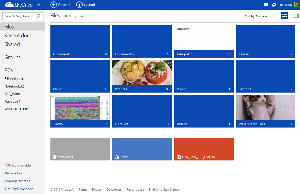 And unlike some of the other file sharing applications I tried, SkyDrive provides file locking so that files won't be mangled by having two people edit a single file simultaneously.
And unlike some of the other file sharing applications I tried, SkyDrive provides file locking so that files won't be mangled by having two people edit a single file simultaneously.
My primary complaint about SkyDrive when Windows 8 first arrived turned out to be a misunderstanding. By default, Office 2013 applications want to store files on SkyDrive and that means saving or opening a large file can be time consuming. Additionally, files stored on SkyDrive aren't backed up locally.
At the right is an example of the Metro interface for SkyDrive.
*Until Microsoft comes up with a replacement name for "Metro", that's what I plan to call it.
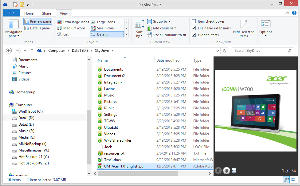 The SkyDrive application sets aside a directory on the local machine where all SkyDrive files are stored. Change a file on the local computer (or add a new file to the SkyDrive folder) and the changes will be replicated within seconds on Microsoft's server and then, also within seconds, on any other computer that has your SkyDrive credentials. Any computer that's not turned on will be updated the next time you start it.
The SkyDrive application sets aside a directory on the local machine where all SkyDrive files are stored. Change a file on the local computer (or add a new file to the SkyDrive folder) and the changes will be replicated within seconds on Microsoft's server and then, also within seconds, on any other computer that has your SkyDrive credentials. Any computer that's not turned on will be updated the next time you start it.
Here's the SkyDrive view you'll see in the Windows Explorer on your desktop.
Users who delete SkyDrive files can restore them from the Recycle Bin back to the original folder and anything in the Recycle Bin doesn't count against the user's storage limit. You can't game the system by keeping large number of files in the Recycle Bin, though. Anything you delete will be recoverable for at least 3 days but after that, you're taking a chance. In some cases, files can be retained for a month. But keep in mind that if the size of files in the Recycle Bin exceeds 10% of the storage limit, SkyDrive will start permanently dropping files, starting with the oldest files in the Recycle Bin.
SkyDrive (originally called "Windows Live Folders") has been around since 2007. In June 2010, an update provided automatic support for Office Web Apps, including support for file versioning.
Late in 2012, another update added the application that makes SkyDrive available in Windows Explorer and also on Apple's OS X. So far, Apple has not made it's file-sharing application available to users of any other operating system.
Users of recent versions of Microsoft Office can use their desktop applications to simultaneously edit the same section of documents stored on SkyDrive. This applies both to users of Windows computers and Macs. Any changes will be synchronized when the document is saved and, in the event of conflicting changes, the user will be offered the option to choose which version to retain.
How Big Data and the Cloud Will Affect You
Anyone who reads publications that deal with data processing at nearly any level has probably seen the term "Big Data" a lot in the past year or so. What is it and how will it affect your business?
"Big Data" (BD from now on) is a collection of data sets so large and complex that existing database management tools often cannot be used to process it. Data processing applications are said to be "scalable" if a process that was developed for a small data set can be used for larger data sets. But there are limits to scalability.
The BD issue is a larger and more severe problem for large corporations and government agencies but it also affects small and medium-size businesses that increasingly find themselves awash in data that they hope to use to identify business trends, determine quality of research, link related documents.
The increasing use of mobile devices, apps, and cloud-based computing exacerbate the problem. Microsoft recently surveyed more than 280 decision makers in midsize and large organizations on the topic of big data. Among their findings: Transforming BD into insights has become a top priority. This isn't exactly a new concept. The understanding that piles of data do not equate to knowledge or understanding isn't new. In other words, the immense number of trees obscures the view of the forest.
Current limits on the size of data sets that can be processed in a reasonable amount of time are measured in exabytes of data. Yes, that's a lot of data. Far more than any medium or small business will have. But even smaller organizations are seeing increases in data that, while they could be handled easily by a mainframe computer, are taxing the limits of desktop systems commonly used in these settings.
The world's technological per-capita capacity to store information has roughly doubled every 40 months since the 1980s and we are currently creating 2.5 quintillion bytes of data every day.
Taming the Flow
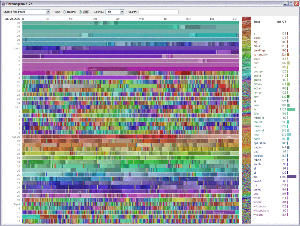 To some extent, hardware is providing, if not a solution to the problem, at least a way to mitigate its effects. Sixty-four-bit computers have been available since the 1960s (although in those days the computers were mammoths, both in terms of size and cost). Intel introduced a 64-bit chip nearly a decade ago and even Windows XP had a 64-bit version, but few people used it.
To some extent, hardware is providing, if not a solution to the problem, at least a way to mitigate its effects. Sixty-four-bit computers have been available since the 1960s (although in those days the computers were mammoths, both in terms of size and cost). Intel introduced a 64-bit chip nearly a decade ago and even Windows XP had a 64-bit version, but few people used it.
The image at the right is from Wikipedia, where it is characterized as "a visualization created by IBM of Wikipedia edits. At multiple terabytes in size, the text and images of Wikipedia are a classic example of big data."
Today, all Macs are 64-bit systems. Many notebook computers have 64-bit processors. Even some tablets come with 64-bit CPUs. Even so, some businesses try to save a few dollars by continuing to use 32-bit hardware. If speed is important to you, selecting a computer with a 64-bit processor is the first step you should take.
The 64-bit hardware opens the door to the next consideration that can improve performance: Memory. The 32-bit systems are limited to 4GB of RAM, of which only about 3GB will be available to applications. By contrast, 64-bit systems can address a virtually unlimited amount of memory. If you're a stickler for facts, there is a limit. It's about 4 petabytes, but good luck finding any mainboard with enough memory slots!
The reason that more memory makes a system faster is easy to understand: When a computer's memory is full, any new operating instructions cannot be placed in memory until what's currently there is written out to the disk. This is called "swapping" and the more times instructions have to be swapped out to disk and then swapped back in the next time they're needed, the slower the computer will run.
Some software manufacturers (Adobe, for example) have already transitioned some of their high-end video processing applications to run only on 64-bit architecture. These applications are so computationally intensive that on a 32-bit system they would be unacceptably slow. Rather than try to maintain 2 versions, Adobe simply decided that the users of these applications will understand the need for faster hardware. And, for the most part, this seems to be true.
A Third Speed Trick
Hard disk drives have become faster but they are still the slowest components in the computer in terms of data transfer. The boot process and loading programs are disk-intensive operations. That's why the fastest and most expensive disk drives come with large amounts of cache memory. Increasingly, though, savvy computer buyers are specifying solid-state disk drives that will hold the computer's operating system and applications.
Unlike standard drives, solid-state drives (SSD) have a limited number of write cycles and eventually the solid-state memory becomes exhausted. SSDs typically arrive with more than the stated amount of memory. This allows for a certain percentage of the drive to be taken out of service over time and still allow the SSD to maintain its rated size. So although SSDs are a smart way to speed a computer's startup operation and decrease the amount of time required to load programs, they're not a particularly good choice for storing data that changes a lot.
The Future of BD
Scientific uses of data provide some insights into where we're going because science runs on data but the rest of the world follows science's lead. So consider ...
The Large Hadron Collider experiments used 150 million sensors that each delivered data 40 million times per second. Scientists were observing nearly 600 million collisions per second and a filtering mechanism eliminated all but about 0.001% of the data streams. Even then, the scientists found about 100 collisions per second that looked interesting. The data flow from the experiments represented 25 petabytes annually but then the data streams are replicated and expand to 200 petabytes.
If the process didn't discard all but 0.001% of the data, scientists would have to deal with about 500 exabytes per day, and that's before replication. Your business needs won't approach data flows of this magnitude for a long, long time but still you've undoubtedly seen increases in the amount of "stuff" you have on hand.
Even for home users, it's not uncommon to have several terabytes of data. The future is arriving quickly and bringing lots of data with in. Yet another driver for big data comes from the (rhetorical) sky.
Cloud-Based Computing
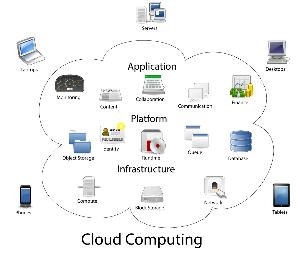 It's been a couple of years since IBM announced (1 Mar 2011) the Smarter Computing framework to support Smarter Planet. Although the framework has several components, one of the most critical is cloud computing.
It's been a couple of years since IBM announced (1 Mar 2011) the Smarter Computing framework to support Smarter Planet. Although the framework has several components, one of the most critical is cloud computing.
Various components of the cloud.
Most of us have never seen a cloud that computes. Nor have any of us ever published a desktop. Even so, the term "cloud computing" seems to have caught on just as "desktop publishing" did in the 1980s and apparently we will have to live with these terms.
At its most basic, Cloud computing entails the use of software that is delivered "as a service" over a network (typically the Internet). Software as a service has earned the entertaining acronym "SaaS" and "cloud computing" is actually based on the use of a cloud symbol in network diagrams in which the cloud represents the network.
Cloud computing also often involves storing a user's data remotely for access at any time from any location that has an Internet connection.
When dealing with cloud-based applications, network speed becomes an important consideration in addition to the speed of the remote computers where the applications are housed. Users often access applications via a Web browser or a light-weight desktop or mobile app. The promoters of cloud-based computing say that this is a way to reduce maintenance, improve manageability, and move new applications into production faster.
Ironically, many of these same claims were made in the 1980s when applications were moved away from central mainframe computers to small computers on users desks.
In fact, the concept of cloud computing dates back to the 1950s. As large mainframe computers became available, video terminals ("dumb terminals") were attached to them to allow individual users to run applications in a time-sharing system.
A 1960s-era computer scientist suggested that computation may someday be organized as a "public utility". That may bring to mind thoughts of the Internet. In 1966, Douglas Parkhill's The Challenge of the Computer Utility examined the future of computing by discussing elastic provisioning of computing services that were provided online essentially as a utility. As far back as the 1950s, scientists were suggesting a world filled with computers (albeit dumb terminals). The future as seen from the 1950s included a dozen or so giant computing centers. In those days, centralization was the only option imaginable because of the cost of computers.
More recently, Amazon has become a key player in cloud computing and even Microsoft has entered the arena with its Windows 8, Office 2013, and SkyDrive. Amazon's gigantic computer centers sometimes use only 10% of their computing capacity to allow for the occasional spike in activity. Performance will be a key consideration if centralized cloud computing is to catch on. If we've learned one thing in the past 30 years that computers have been available on our desktops, it's this: Nobody likes waiting for a computer.
Photography Continues to Evolve
The Kodak bankruptcy may be the most obvious example of how much photography has changed in the past 15 years or so and for Rochester, New York, the change has been devastating. A friend of mine closed his photo studio less than a year ago. The studio once photographed hundreds of weddings every year but, at closing, only a few were on the schedule. Increasingly, photography is a do-it-yourself undertaking.
Photography used to be such a difficult business: You started by shooting people, which let to nothing but negatives. After that, you had to blow them up, frame them, and finally hang them.
Remember Spiratone?
Spiratone specialized in low-cost lenses and filters for cameras, lighting, and darkroom equipment. Fred Spira started the company in 1941. He developed film in the bathroom of his parents' apartment. In 1946, he moved to a loft on West 27th Street. Eventually the company grew into a multi-million dollar company. Mail orders were filled from a warehouse store in Flushing.
The New York Times reported Spira's death, at 83, in 2007, and the obituary noted accurately that "amateur and professional photographers awaited each gadget catalog as if they were children waiting for a Christmas toy catalog." Spira's company was one of the first to import Japanese photo equipment to the United States but Spiratone never sold cameras. Business declined starting in the 1980s and Spiratone went out of business in 1990, 3 years after Spira retired. I still have some of the gadgets that the company sold.
Many people have a love-hate relationship with Photoshop and Paul Miller explains why.
I had hoped to have a longer section on photography this week, but hardware problems have pushed it to the background. Expect more about photography soon.
Short Circuits
An Update on Digital Magazines
Newsweek, it seems to me, continues to struggle in an all-digital world. It's not the magazine, which has improved greatly. By going digital and eliminating the cost of paper, printing, and mailing, the publisher has been able to enlarge the size considerably. The problem continues to be the download speed and the large number of formats that must be supported.
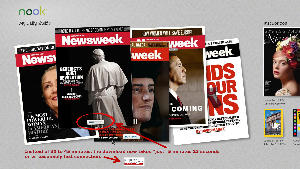 That said, though, I should say that Barnes and Noble has made significant improvements. Now the Nook Reader manages to download an entire issue in about 5 and a half minutes. That's far better than the 30 to 45 minutes that I had to wait initially but it's still far too slow, particularly on a 15Mbps connection.
That said, though, I should say that Barnes and Noble has made significant improvements. Now the Nook Reader manages to download an entire issue in about 5 and a half minutes. That's far better than the 30 to 45 minutes that I had to wait initially but it's still far too slow, particularly on a 15Mbps connection.
I've already ruled out Zinio as being unreliable and unusable. Not having an Ipad, I haven't been able to test drive the Itunes version but there is no Kindle version for my antique device, only for the various Fire versions. And I haven't looked at Newsweek's interactive Web reader for a while but initially I found it to be unreliable and largely unusable. The Nook Reader is by far the best interface for reading magazines but Barnes and Noble must do something about the speed.
Apparently Newsweek has heard from less-than-happy subscribers and has finally published e-mail addresses that people can use to contact someone in customer service.
I'll probably continue to grumble about the amount of time required to download Newsweek but at least the process is now fast enough that I no longer feel like throwing the computer out the window.
Google Glass: Better than Beer Glasses?
Win a contest that Google is running and you'll have the opportunity to acquire a pair of Google Internet Glass. For $1500. Google says these are the next breakthrough in mobile computing. Or maybe it's another distraction for drivers that will push Google's project to build cars that drive themselves.
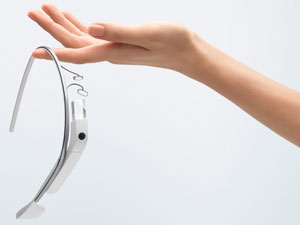 Google announced the contest this week but didn't say how many pairs of Google Glass for which it plans to award options to purchase. If you have a spare $1500 around want want to give it a try, use Google Plus or Twitter to submit your application (maximum 50 words) with the hashtag "ifihadglass" no later than Wednesday, 27 Feb 2013. You could be a lucky spender.
Google announced the contest this week but didn't say how many pairs of Google Glass for which it plans to award options to purchase. If you have a spare $1500 around want want to give it a try, use Google Plus or Twitter to submit your application (maximum 50 words) with the hashtag "ifihadglass" no later than Wednesday, 27 Feb 2013. You could be a lucky spender.
If you win, you'll be able to buy a copy of the beta model of Google Glass. You won't be the first to own them though. Google sold copies of the glasses (also for $1500) to some computer programmers last June.
Google says the devices will do much of what a smart phone does today except they will respond to voice commands instead of push buttons. A small display is attached to the right eyepiece. The operating system for the Google Glass glasses is, of course, Android.
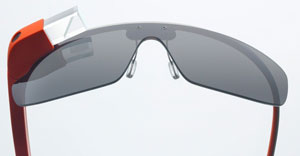 So now pedestrians who are distracted by Google Glass will be able to walk into the paths of motorists who are also distracted by Google Glass. Sounds like a good way to clean the gene pool.
So now pedestrians who are distracted by Google Glass will be able to walk into the paths of motorists who are also distracted by Google Glass. Sounds like a good way to clean the gene pool.
Google says the glasses will be easier to use for people who want to take pictures or record a video. I can see it now: An upgrade to YouTube will allow people to stream video from their glasses 24/7. (Truth in reporting: That was hyperbole. I think. At least, that was my intent.)
A video by Google shows Google Glass wearers skiing, horse-riding, and skydiving. One user is on a roller coaster.
Google Glass will be available in charcoal, tangerine, shale, cotton, and sky blue. For more information, see the Google Blog.
Old Technology Never Goes Away; It Returns as a Smart Phone App
Case in point: Tamagotchi. Remember them? In the 1990s, you could buy a Tamagotchi pet (an egg-shaped plastic toy) that would periodically request food, water, or attention. Ignore it long enough and it would die. Now you'll be able to add a Tamagotchi to your smart phone and this might make your phone a bit less intelligent.
Bandai developed the Tamagotchi and now Sync Beatz Entertainment has licensed the technology. If you have an Android device, you can re-live the mid 1990s by adding the app. Tamagotchi L.i.f.e. And if you wondered, "L.i.f.e" turns out to be an acronym for "love is fun everywhere."
![]() The game is based on the original Tamagotchi but it has something the original didn't have: It can be updated and Sync Beatz plans to do that about every 2 months. They also plan to make it available for Apple devices.
The game is based on the original Tamagotchi but it has something the original didn't have: It can be updated and Sync Beatz plans to do that about every 2 months. They also plan to make it available for Apple devices.
The Tamagotchi L.i.f.e. is being offered for "free" (meaning that it's supported by advertising). If you don't want the ads, you'll be able to get rid of them for $1 (99 cents in marketing-speak).
The kids who played with the Tamagotchi toys a decade and a half ago are now in their 20s and 30s. Given the popularity of apps such as FarmVille, the Tamagotchi app will probably prove to be popular.
Oh—and coming soon: Tamagotchi L.i.f.e. products that will include clothing, accessories, and other stuff.
